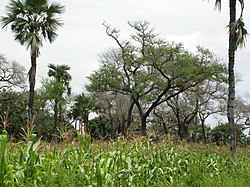
Back حراجة زراعية Arabic Aqromeşəmeliorasiya Azerbaijani কৃষিবনবিদ্যা Bengali/Bangla Agroforesteria Catalan Agrolesnictví Czech Skovlandbrug Danish Agroforstwirtschaft German Agroforstumado Esperanto Agroforestería Spanish دارکشتورزی Persian


Agroforestry (also known as agro-sylviculture or forest farming) is a land use management system that integrates trees with crops or pasture. It combines agricultural and forestry technologies. As a polyculture system, an agroforestry system can produce timber and wood products, fruits, nuts, other edible plant products, edible mushrooms, medicinal plants, ornamental plants, animals and animal products, and other products from both domesticated and wild species.[1]
Agroforestry can be practiced for economic, environmental, and social benefits, and can be part of sustainable agriculture.[2] Apart from production, benefits from agroforestry include improved farm productivity,[3] healthier environments, reduction of risk for farmers,[4] beauty and aesthetics, increased farm profits, reduced soil erosion, creating wildlife habitat, less pollution, managing animal waste, increased biodiversity, improved soil structure, and carbon sequestration.
Agroforestry practices are especially prevalent in the tropics, especially in subsistence smallholdings areas, with particular importance in sub-Saharan Africa.[5] Due to its multiple benefits, for instance in nutrient cycle benefits and potential for mitigating droughts, it has been adopted in the US and Europe.

- ^ Mudge, Ken; Gabriel, Steve (2014). Farming the Woods: an integrated permaculture approach to growing food and medicinals in temperate forests. White River Junction, VT: Chelsea Green Publishing. p. 9. ISBN 978-1-60358-507-1.
- ^ "What is agroforestry?". www.aftaweb.org. Retrieved 29 April 2018.
- ^ Bizzo, Eduardo; Michener, Gregory (17 March 2024). "Fostering sustainable production via the Amazon Fund collaborative platform". Sustainable Development. 32 (5): 5129–5143. doi:10.1002/sd.2956 – via CrossRef.
- ^ MacDicken, Kenneth G.; Vergara, Napoleon T. (1990). Agroforestry: classification and management. John Wiley & Sons, Inc. p. 2. ISBN 0-471-83781-4.
- ^ Jamnadass, R.H.; Dawson, I.K.; Franzel, S.; Leakey, R.R.B.; Mithöfer, D.; Akinnifesi, F.K.; Tchoundjeu, Z. (1 September 2011). "Improving livelihoods and nutrition in sub-Saharan Africa through the promotion of indigenous and exotic fruit production in smallholders' agroforestry systems: a review". International Forestry Review. 13 (3): 338–354. doi:10.1505/146554811798293836.